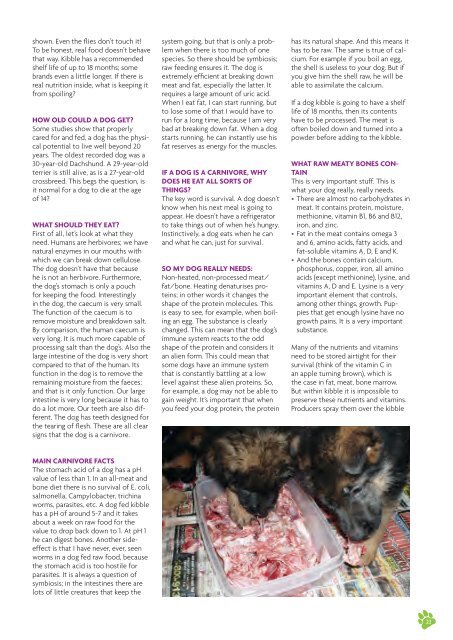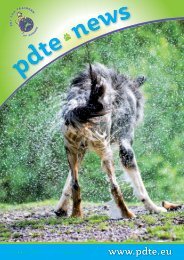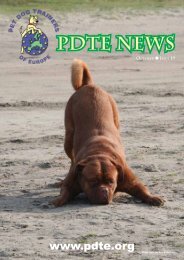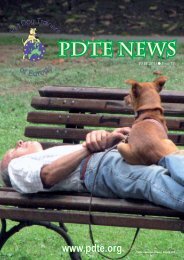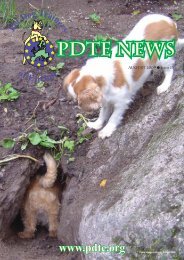PDTE 2013 Winter Newsletter
Create successful ePaper yourself
Turn your PDF publications into a flip-book with our unique Google optimized e-Paper software.
shown. Even the flies don’t touch it!<br />
To be honest, real food doesn’t behave<br />
that way. Kibble has a recommended<br />
shelf life of up to 18 months; some<br />
brands even a little longer. If there is<br />
real nutrition inside, what is keeping it<br />
from spoiling?<br />
HOW OLD COULD A DOG GET?<br />
Some studies show that properly<br />
cared for and fed, a dog has the physical<br />
potential to live well beyond 20<br />
years. The oldest recorded dog was a<br />
30-year-old Dachshund. A 29-year-old<br />
terrier is still alive, as is a 27-year-old<br />
crossbreed. This begs the question, is<br />
it normal for a dog to die at the age<br />
of 14?<br />
WHAT SHOULD THEY EAT?<br />
First of all, let’s look at what they<br />
need. Humans are herbivores; we have<br />
natural enzymes in our mouths with<br />
which we can break down cellulose.<br />
The dog doesn’t have that because<br />
he is not an herbivore. Furthermore,<br />
the dog’s stomach is only a pouch<br />
for keeping the food. Interestingly<br />
in the dog, the caecum is very small.<br />
The function of the caecum is to<br />
remove moisture and breakdown salt.<br />
By comparison, the human caecum is<br />
very long. It is much more capable of<br />
processing salt than the dog’s. Also the<br />
large intestine of the dog is very short<br />
compared to that of the human. Its<br />
function in the dog is to remove the<br />
remaining moisture from the faeces;<br />
and that is it only function. Our large<br />
intestine is very long because it has to<br />
do a lot more. Our teeth are also different.<br />
The dog has teeth designed for<br />
the tearing of flesh. These are all clear<br />
signs that the dog is a carnivore.<br />
system going, but that is only a problem<br />
when there is too much of one<br />
species. So there should be symbiosis;<br />
raw feeding ensures it. The dog is<br />
extremely efficient at breaking down<br />
meat and fat, especially the latter. It<br />
requires a large amount of uric acid.<br />
When I eat fat, I can start running, but<br />
to lose some of that I would have to<br />
run for a long time, because I am very<br />
bad at breaking down fat. When a dog<br />
starts running, he can instantly use his<br />
fat reserves as energy for the muscles.<br />
IF A DOG IS A CARNIVORE, WHY<br />
DOES HE EAT ALL SORTS OF<br />
THINGS?<br />
The key word is survival. A dog doesn’t<br />
know when his next meal is going to<br />
appear. He doesn’t have a refrigerator<br />
to take things out of when he’s hungry.<br />
Instinctively, a dog eats when he can<br />
and what he can, just for survival.<br />
SO MY DOG REALLY NEEDS:<br />
Non-heated, non-processed meat/<br />
fat/bone. Heating denaturises proteins;<br />
in other words it changes the<br />
shape of the protein molecules. This<br />
is easy to see, for example, when boiling<br />
an egg. The substance is clearly<br />
changed. This can mean that the dog’s<br />
immune system reacts to the odd<br />
shape of the protein and considers it<br />
an alien form. This could mean that<br />
some dogs have an immune system<br />
that is constantly battling at a low<br />
level against these alien proteins. So,<br />
for example, a dog may not be able to<br />
gain weight. It’s important that when<br />
you feed your dog protein, the protein<br />
has its natural shape. And this means it<br />
has to be raw. The same is true of calcium.<br />
For example if you boil an egg,<br />
the shell is useless to your dog. But if<br />
you give him the shell raw, he will be<br />
able to assimilate the calcium.<br />
If a dog kibble is going to have a shelf<br />
life of 18 months, then its contents<br />
have to be processed. The meat is<br />
often boiled down and turned into a<br />
powder before adding to the kibble.<br />
WHAT RAW MEATY BONES CON-<br />
TAIN<br />
This is very important stuff. This is<br />
what your dog really, really needs.<br />
• There are almost no carbohydrates in<br />
meat. It contains protein, moisture,<br />
methionine, vitamin B1, B6 and B12,<br />
iron, and zinc.<br />
• Fat in the meat contains omega 3<br />
and 6, amino acids, fatty acids, and<br />
fat-soluble vitamins A, D, E and K.<br />
• And the bones contain calcium,<br />
phosphorus, copper, iron, all amino<br />
acids (except methionine), lysine, and<br />
vitamins A, D and E. Lysine is a very<br />
important element that controls,<br />
among other things, growth. Puppies<br />
that get enough lysine have no<br />
growth pains. It is a very important<br />
substance.<br />
Many of the nutrients and vitamins<br />
need to be stored airtight for their<br />
survival (think of the vitamin C in<br />
an apple turning brown), which is<br />
the case in fat, meat, bone marrow.<br />
But within kibble it is impossible to<br />
preserve these nutrients and vitamins.<br />
Producers spray them over the kibble<br />
MAIN CARNIVORE FACTS<br />
The stomach acid of a dog has a pH<br />
value of less than 1. In an all-meat and<br />
bone diet there is no survival of E. coli,<br />
salmonella, Campylobacter, trichina<br />
worms, parasites, etc. A dog fed kibble<br />
has a pH of around 5-7 and it takes<br />
about a week on raw food for the<br />
value to drop back down to 1. At pH 1<br />
he can digest bones. Another sideeffect<br />
is that I have never, ever, seen<br />
worms in a dog fed raw food, because<br />
the stomach acid is too hostile for<br />
parasites. It is always a question of<br />
symbiosis; in the intestines there are<br />
lots of little creatures that keep the<br />
Talks in AGM 2012<br />
23


